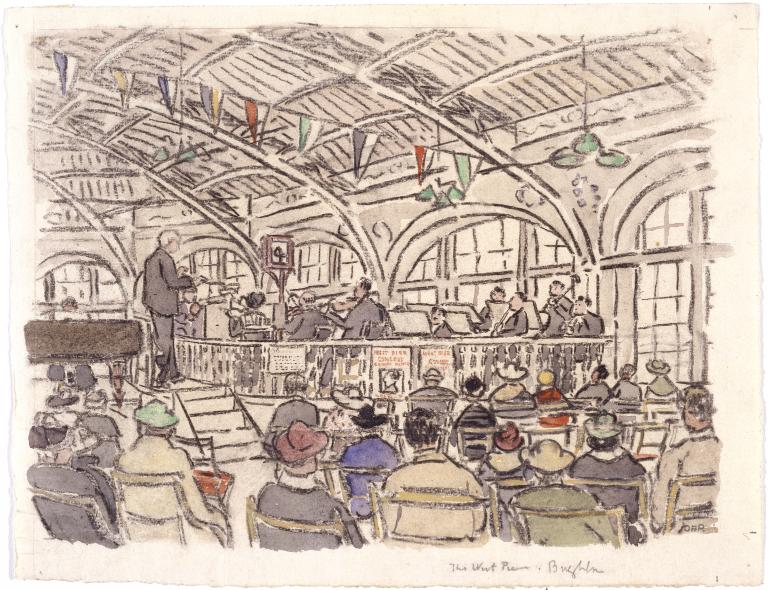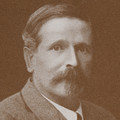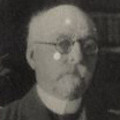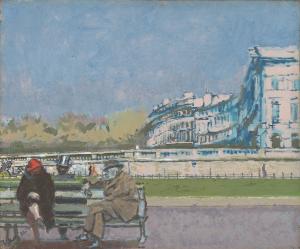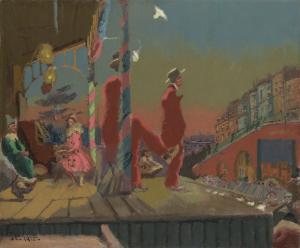Douglas Fox Pitt Concert on the West Pier, Brighton c.1916-18
Douglas Fox Pitt,
Concert on the West Pier, Brighton
c.1916-18
The grand concert hall on Brighton’s West Pier opened in 1916. Fox Pitt’s watercolour probably depicts a daytime orchestra concert, with charcoal outlines emphasising the iron girders supporting the hall’s roof. Made during the First World War, the painting shows a number of empty seats and a loosely arranged audience including men who may be above the age of military conscription.
Douglas Fox Pitt 1864–1922
Concert on the West Pier, Brighton
c.1916–18
Charcoal and watercolour on paper
233 x 305 mm
Inscribed in pencil ‘The West Pier. Brighton’ bottom centre right and ‘D.F.P.’ bottom right of image
Presented by Miss Patience Scott 1924
N03994
c.1916–18
Charcoal and watercolour on paper
233 x 305 mm
Inscribed in pencil ‘The West Pier. Brighton’ bottom centre right and ‘D.F.P.’ bottom right of image
Presented by Miss Patience Scott 1924
N03994
Ownership history
By descent from the artist to his niece Patience Scott 1922, by whom presented to Tate Gallery 1924.
Exhibition history
1951
Edwardian Exhibition, Towner Art Gallery, Eastbourne, July–September 1951 (117).
1962
The Painter’s Brighton, Brighton Art Gallery and Museum, July 1962 (63).
1995–6
Brighton Revealed: Through Artists’ Eyes c.1760–c.1960, Royal Pavilion, Brighton, November 1995–January 1996 (111, reproduced).
References
1964
Mary Chamot, Dennis Farr and Martin Butlin, Tate Gallery Catalogues: The Modern British Paintings, Drawings and Sculpture, vol.1, London 1964, p.185.
Technique and condition
Executed with charcoal and watercolour on laid cream paper, The Concert on the West Pier, Brighton is inscribed with the title and the artist’s signature in graphite at the bottom right corner. The paper is medium weight and of good quality and has kept its strength. It has uneven edges that are torn on three edges and a deckle edge on the left. There are three creases running along the lower left edge and pinholes in the four corners.
The charcoal lines are neatly drawn with uniform width and tone. Watercolour has been applied in solid blocks to areas of the image, principally over the drawing. A fixative seems to have been used on the charcoal drawing as it has not been adversely affected by the application of the watercolour. However, the charcoal has become abraded in areas. The original tone of the watercolour is well preserved.
The paper undulates slightly overall and while there are some minor foxing spots, generally it is in good condition.
Tomoko Kawamura
June 2004
How to cite
Tomoko Kawamura, 'Technique and Condition', June 2004, in Robert Upstone, ‘Concert on the West Pier, Brighton c.1916–18 by Douglas Fox Pitt’, catalogue entry, July 2009, in Helena Bonett, Ysanne Holt, Jennifer Mundy (eds.), The Camden Town Group in Context, Tate Research Publication, May 2012, https://wwwEntry
This picture has formerly been dated in Tate catalogues c.1911–18, but it must post-date 1916 as this was when the concert hall opened on the West Pier. Fox Pitt moved to Brighton in 1911, and remained there until 1918 when he moved to Thorpe in Surrey. The painting of Concert on the West Pier, Brighton appears therefore to date from the years 1916–18.
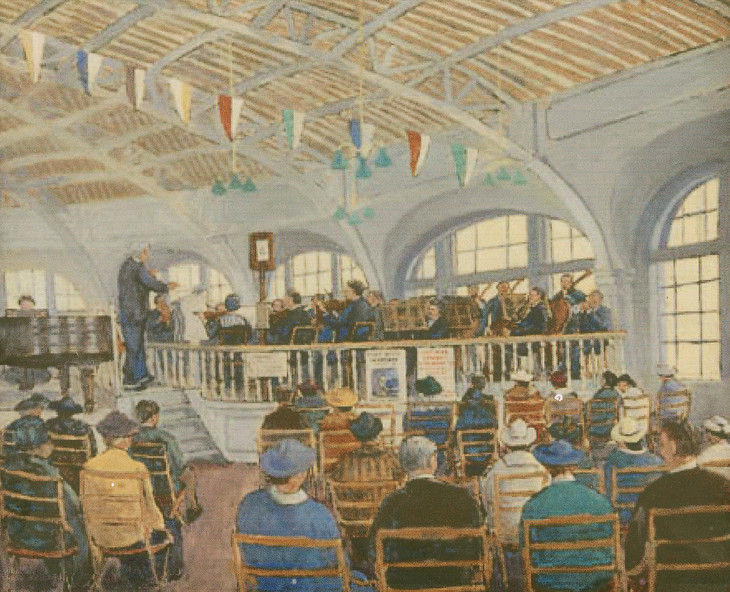
Douglas Fox Pitt 1864–1922
Concert on the West Pier, Brighton c.1918
Oil paint on canvas
Whole: 500 x 610 mm
Royal Pavilion and Museum, Brighton and Hove
Reproduced with the kind permission of The Royal Pavilion and Museums (Brighton & Hove)
Fig.1
Douglas Fox Pitt
Concert on the West Pier, Brighton c.1918
Royal Pavilion and Museum, Brighton and Hove
Reproduced with the kind permission of The Royal Pavilion and Museums (Brighton & Hove)
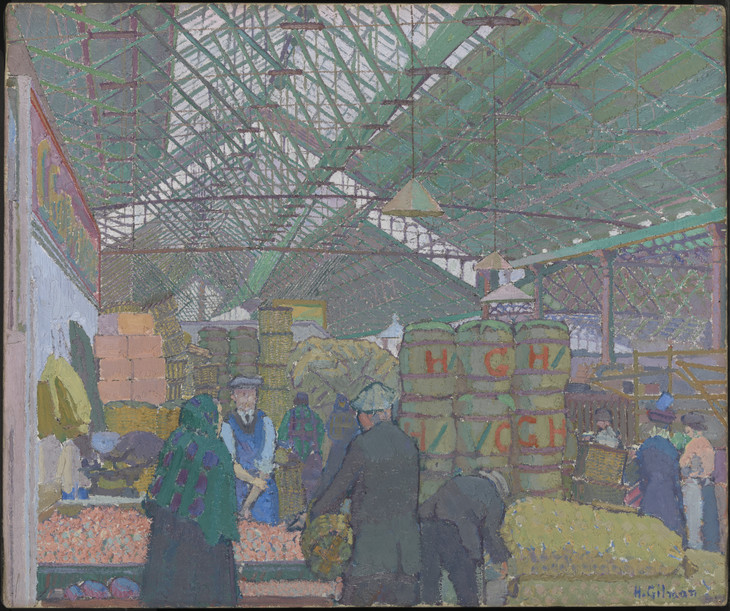
Harold Gilman 1876–1919
Leeds Market c.1913
Oil paint on canvas
support: 508 x 610 mm; frame: 690 x 790 x 75 mm
Tate N04273
Presented by the Very Rev. E. Milner-White 1927
Fig.2
Harold Gilman
Leeds Market c.1913
Tate N04273
Fox Pitt was a close associate of the Camden Town Group and a collector of their pictures. But in the simplicity and unfussiness of his draughtsmanship and his use of bright colours he also shared a stylistic affinity with their working methods. Sickert commented on him in a letter dated 10 October 1913 to Nan Hudson, noting the old-fashioned nature of his clothing: ‘I saw a lovely etching of yours in Fox Pitt’s little house in Brighton. That man is rather touching. He wears old pea jackets of the eighties over his no longer 1880 tum to buy our pictures!’5 In the introduction he wrote to the memorial exhibition for Fox Pitt held at the Public Art Gallery in Brighton in 1923, James Bolivar Manson summarised how he fitted into the circle of artists around him:
Douglas Fox-Pitt, whose work has a personal charm and method of its own, was one of those artists who belonged to the transition period between established academic art and the modern school. He was undoubtedly influenced by the modern growth around him, and he followed with sympathetic interest the development of modern ideas in painting, but his own work proceeded strictly along the lines of personal conviction. He made no surrender to the demands of modernity for the sake of réclame ... He took a keen interest in most forms of mental activity, and he expressed his views, which were somewhat unconventional, with courage and vigour. He was a staunch friend, kindly and shrewd.6
In common with a number of drawings from this period, Fox Pitt has drawn the outlines of the forms in charcoal without any tonal shading. He has then tinted the areas enclosed by the outline with solid blocks of watercolour. Fox Pitt made another version of Concert on the West Pier, Brighton, identical except for having no application of watercolour. Although neither is squared for transfer, both appear to be studies for the oil painting that is in Brighton Museum and Art Gallery (see fig.1), a very rare excursion in oils by the artist.
Robert Upstone
July 2009
Notes
Related biographies
Related essays
- Leisure Interiors in the Work of the Camden Town Group Jonathan Black, Fiona Fisher and Penny Sparke
Related catalogue entries
How to cite
Robert Upstone, ‘Concert on the West Pier, Brighton c.1916–18 by Douglas Fox Pitt’, catalogue entry, July 2009, in Helena Bonett, Ysanne Holt, Jennifer Mundy (eds.), The Camden Town Group in Context, Tate Research Publication, May 2012, https://www

